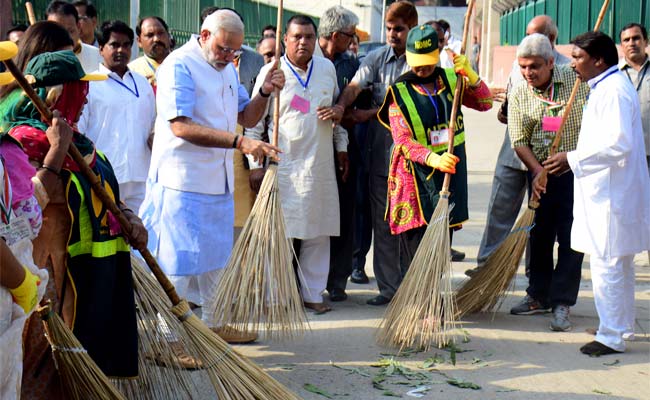What are the recent updates on Swachh Bharat Abhiyan?
- The union government had launched Swachh Bharat Abhiyan(SBA) on 2 October 2014 with two submissions, SBA (gramin) and SBA (urban).
- Budgetary provisions for the two submissions will be provided separately in the Demand for Grants of the Ministry of Drinking Water and Sanitation (MDWS) (for gramin) and the Ministry of Urban Development (for urban).
- Two other ministries, the Ministry of Women and Child Development (MWCD) and the Ministry of Human Resource Development (MHRD), more specifically, the latter’s Department of School Education and Literacy, will be responsible for the construction of anganwadi and school toilets.
Let’s go back in time and come forward via a timeline, shall we?
- Prior to the onset of SBA, the first major intervention by the union government was the Accelerated Rural Water Supply Programme (ARWSP) in 1972–73, to support states and union territories with financial and technical assistance to implement drinking water supply schemes in “problem villages.”
- In 1986, a technology mission with stress on water quality, appropriate technology intervention, human resource development support and other related activities was introduced. This was renamed as the Rajiv Gandhi National Drinking Water Mission (RGNDWM) in 1991.
- In 1999–2000, sector reform projects were evolved to involve the community in planning, implementation and management of drinking water-related schemes.
- In 2002, this was scaled up as the Swajaldhara programme.
- From 2009 onwards, it was rechristened as the National Rural Drinking Water Programme (NRDWP).
The NRDWP and the Nirmal Bharat Abhiyan (NBA) have been the union government’s flagship programmes for rural drinking water and sanitation.
However, the SBA draft, circulated on 22 August 2014, combines the drinking water supply and sanitation programmes and wishes to achieve safe-water supply and open defecation-free status in both urban and rural India by 2019, the year that will mark the 150th birth anniversary of Mahatma Gandhi.
Can India be swachh without the caste ethos being completely eradicated?
The Government draft acknowledges the need for better drinking water and sanitation facilities in both rural and urban India, especially for women and children.
Some words from Government draft,
“While having a toilet is important for everyone, access to safe, clean toilets brings particular benefits to women and girls. Freed from the need to defecate in the open, they no longer have to suffer the indignity, humiliation and often verbal and physical abuse when relieving themselves. Sexual harassment and rape are a risk for many women who without a household toilet have to wait until nightfall to seek the privacy of darkness outside to relieve themselves. Women and girls don’t need toilet facilities just for defecation; they also need privacy and dignity when menstruating. The symptoms of menstruation, pregnancy and the postnatal periods become more traumatic if women have no space to deal with them. The need for sanitation facilities within homes and in public places, which meet women’s physical and psychological demands, cannot be overemphasized. (GoI 2014).
The draft deals with key challenges and the way forward to make the mission successful.
- Behavioural change influencing 590 million population in rural areas, the problem of convergence between the Mahatma Gandhi National Rural Employment Guarantee Scheme (MGNREGS) and NBA, lack of water availability in toilets, defunct toilets, inadequacy of staff at the ground level, these are the key challenges noted by the draft.
- A recent study by Coffey et al (2014) found that “many survey respondents’ behaviour reveals a preference for open defecation: over 40% of households with a working latrine have at least one member who defecates in the open.” Open defecation is a socially accepted traditional behaviour in India, especially in rural areas.
- It has been a tough job to convince a section of the population to regularly use constructed toilets. But, countries like Bangladesh and Indonesia have shown remarkable change in behaviour towards sanitation after comprehensive information, education and communication (IEC) was imparted.
- Grants to the States : “It would be better to release not as per the present formula giving entitlement of States, but on a projected basis, on the basis of the Detailed Project Report of a district as a whole both for water and sanitation.”
What are the key financial roles for this mission to be a success?
Well, At the moment, government is relying on the corporate social responsibility (CSR) and individual donations for funds. The fund under CSR would be channelled through Swachh Bharat Kosh (SBK) headed by secretary, Department of Expenditure.
The SBA introduces awards for panchayati raj institutions (gram panchayats, block panchayats and district panchayats), individuals, officers, non-governmental organisations (NGO) and also for best practices.
Parting Words
- Quite a bit of euphoria has been in the air with regard to the SBA, thanks to extensive media coverage.
- Responses to SBA can be categorised under two heads –
- On the one hand, the upper classes/castes have appreciated the effort; they envisage a business opportunity and visualise a dirt-free India (in their eyes, dirt is associated with the lower castes/classes).
- On the other hand, a large section of population (the deprived) has no clue as to what has been going around in the name of swachhta.
But one thing for sure, without sufficient capital and well-trained labour, this mission may miss its deadline.
What do you think?
Published with inputs from Arun.

